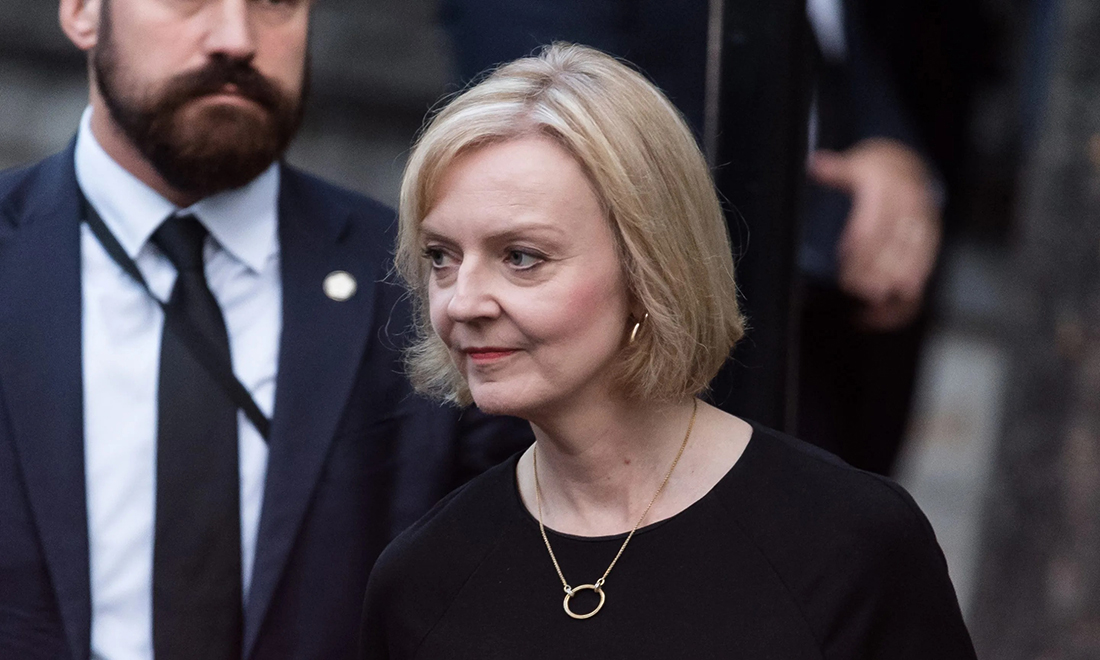
新的一周来临,英国政府公布财政计划后,市场抛售仍在持续,首相利兹·特拉斯刚刚上台几天的政府面临巨大压力。
9月23日,英国财政大臣夸西·克沃滕为刺激经济,孤注一掷地推出了减税和额外借款计划,投资者反应激烈且极其负面,英国资产暴跌。上周末,夸西承诺进一步减税,似乎对市场反应毫不在意。
当9月26日亚洲市场开市时,下跌几乎没有减弱势头,深陷困境的英镑兑美元汇率跌至37年来新低。如果本周交易员继续实时反馈市场情绪,跌势就将继续加深,抛售风险可能不仅导致政府短期内陷入尴尬,而是进入更严重的危机,政策要迅速回应。
9月25日晚的英镑跌幅高达0.9%,跌至1.08美元以下,所以9月26日早上8点的英国国债市场也值得关注。
“由于财政领域普遍的非公开支出无法匹配货币政策从而抵消通胀冲动,英镑可能进一步走软。”包括卡马克夏·特里维德在内等高盛集团(Goldman Sachs)的分析师在9月23日发给客户的一份报告中写道。
9月23日差点成为自2016年英国脱欧(Brexit)投票后创纪录崩盘以来英镑兑美元汇率最惨的一天,由此能够看出其在历史上的严重程度。收盘时跌幅达3.6%,为过去50年里第七大跌幅。与此同时,由于投资者惩罚财政大臣只顾追求增长还毫无悔意,政府债券收益率飙升,某些久期的债券收益率更是创下纪录。
如果当前情况继续保持,由于英国智库Resolution Foundation预计未来五年的计划需要额外举债4,000亿英镑(约合4,340亿美元),收益率走高就将导致借款成本大大增加。与此同时,因为通胀率居高不下和英国央行(Bank of England)加息,利息账单已经不断膨胀。
上周的市场走势可能造成巨大影响。《每日电讯报》(The Telegraph)9月24日称,如果英镑降至与美元等值,特拉斯的减税政策就将面临保守党后座议员的反对。与此同时,一些市场人士已经呼吁英国央行紧急采取行动遏制英镑贬值趋势,毕竟当代英镑如此走低前所未有,可能加剧恐慌。
英国央行的前官员亚当·波森在推特(Twitter)上称,预计英国央行的行长安德鲁·贝利将“在周中之前公开表示,如果英镑下跌,利率就会上升。”他还提到财政部有可能在9月25日开市前干预英镑,但其他人指出,英国的外汇储备比起日本等国少很多,而其他国家采取了相同的政策。
如果周末可以让市场稍微平息,而且从9月26日开始回调,就能够为特拉斯和克沃滕争取一些夺回议程的时间。今年10月初保守党会议的重要性有所提升,原本的会议主题是新政府上台,如今可能变成政府恢复受损信誉的机会。
但在市场上,很多人对前景非常不乐观。上周动荡后出现了更多的预测,连美国财政部的前部长劳伦斯·萨默斯都预测称英镑将跌破与美元平价。彭博(Bloomberg)的期权定价模型显示,未来六个月英镑兑美元降到1的概率为四分之一,比9月22日的14%要高。
其他人则比较担心将来的英国债务。令人不安的是,以前央行通过量化宽松政策提供支持是英国国债的救星,现在却因为官员试图控制失控的价格飙升而起反作用。
“英国国债市场正在逐渐调整,以适应财政形势剧烈变化和巨大的供需前景。” 9月23日汇丰银行(HSBC)的分析师在一份报告里写道。“大规模借贷回归之际,英国央行也从债券买家转为卖家,更重要的是,其他投资者越发担心英国财政的信誉。”
在克沃滕于9月23日发表演讲后,英镑下跌,10年期债券收益率上升30多个基点达到3.83%,五年期债券利率创纪录地上升51个基点。
与此同时,交易员预计在今年11月3日的英国央行会议上,将继续加息120个基点,加息幅度为9月22日将利率提升至2.25%的幅度两倍还多。交易商间经纪公司Tradition Ltd.的国债经纪和代理部门负责人特雷沃尔·皮尤表示,交易员也在考虑会议期间加息的可能性。
英镑大贬后,新任财政大臣否认出现投资者恐慌,还告诉英国的《金融时报》(Financial Times),“市场总在波动——保持冷静且关注长期战略非常重要。”
目前,市场对长期战略的看法似乎并不明确。
“除非切实采取措施解决财政问题,或者经济出现令人惊喜的强劲增长数据,否则投资者可能将继续避开英镑。”荷兰国际集团(ING)的安托万·布韦和克里斯·特纳在9月23日写道。“我们认为美元反弹也存在超速上涨现象,所以市场可能低估了英镑与美元平价的几率。”(财富中文网)
译者:夏林
新的一周来临,英国政府公布财政计划后,市场抛售仍在持续,首相利兹·特拉斯刚刚上台几天的政府面临巨大压力。
9月23日,英国财政大臣夸西·克沃滕为刺激经济,孤注一掷地推出了减税和额外借款计划,投资者反应激烈且极其负面,英国资产暴跌。上周末,夸西承诺进一步减税,似乎对市场反应毫不在意。
当9月26日亚洲市场开市时,下跌几乎没有减弱势头,深陷困境的英镑兑美元汇率跌至37年来新低。如果本周交易员继续实时反馈市场情绪,跌势就将继续加深,抛售风险可能不仅导致政府短期内陷入尴尬,而是进入更严重的危机,政策要迅速回应。
9月25日晚的英镑跌幅高达0.9%,跌至1.08美元以下,所以9月26日早上8点的英国国债市场也值得关注。
“由于财政领域普遍的非公开支出无法匹配货币政策从而抵消通胀冲动,英镑可能进一步走软。”包括卡马克夏·特里维德在内等高盛集团(Goldman Sachs)的分析师在9月23日发给客户的一份报告中写道。
9月23日差点成为自2016年英国脱欧(Brexit)投票后创纪录崩盘以来英镑兑美元汇率最惨的一天,由此能够看出其在历史上的严重程度。收盘时跌幅达3.6%,为过去50年里第七大跌幅。与此同时,由于投资者惩罚财政大臣只顾追求增长还毫无悔意,政府债券收益率飙升,某些久期的债券收益率更是创下纪录。
如果当前情况继续保持,由于英国智库Resolution Foundation预计未来五年的计划需要额外举债4,000亿英镑(约合4,340亿美元),收益率走高就将导致借款成本大大增加。与此同时,因为通胀率居高不下和英国央行(Bank of England)加息,利息账单已经不断膨胀。
上周的市场走势可能造成巨大影响。《每日电讯报》(The Telegraph)9月24日称,如果英镑降至与美元等值,特拉斯的减税政策就将面临保守党后座议员的反对。与此同时,一些市场人士已经呼吁英国央行紧急采取行动遏制英镑贬值趋势,毕竟当代英镑如此走低前所未有,可能加剧恐慌。
英国央行的前官员亚当·波森在推特(Twitter)上称,预计英国央行的行长安德鲁·贝利将“在周中之前公开表示,如果英镑下跌,利率就会上升。”他还提到财政部有可能在9月25日开市前干预英镑,但其他人指出,英国的外汇储备比起日本等国少很多,而其他国家采取了相同的政策。
如果周末可以让市场稍微平息,而且从9月26日开始回调,就能够为特拉斯和克沃滕争取一些夺回议程的时间。今年10月初保守党会议的重要性有所提升,原本的会议主题是新政府上台,如今可能变成政府恢复受损信誉的机会。
但在市场上,很多人对前景非常不乐观。上周动荡后出现了更多的预测,连美国财政部的前部长劳伦斯·萨默斯都预测称英镑将跌破与美元平价。彭博(Bloomberg)的期权定价模型显示,未来六个月英镑兑美元降到1的概率为四分之一,比9月22日的14%要高。
其他人则比较担心将来的英国债务。令人不安的是,以前央行通过量化宽松政策提供支持是英国国债的救星,现在却因为官员试图控制失控的价格飙升而起反作用。
“英国国债市场正在逐渐调整,以适应财政形势剧烈变化和巨大的供需前景。” 9月23日汇丰银行(HSBC)的分析师在一份报告里写道。“大规模借贷回归之际,英国央行也从债券买家转为卖家,更重要的是,其他投资者越发担心英国财政的信誉。”
在克沃滕于9月23日发表演讲后,英镑下跌,10年期债券收益率上升30多个基点达到3.83%,五年期债券利率创纪录地上升51个基点。
与此同时,交易员预计在今年11月3日的英国央行会议上,将继续加息120个基点,加息幅度为9月22日将利率提升至2.25%的幅度两倍还多。交易商间经纪公司Tradition Ltd.的国债经纪和代理部门负责人特雷沃尔·皮尤表示,交易员也在考虑会议期间加息的可能性。
英镑大贬后,新任财政大臣否认出现投资者恐慌,还告诉英国的《金融时报》(Financial Times),“市场总在波动——保持冷静且关注长期战略非常重要。”
目前,市场对长期战略的看法似乎并不明确。
“除非切实采取措施解决财政问题,或者经济出现令人惊喜的强劲增长数据,否则投资者可能将继续避开英镑。”荷兰国际集团(ING)的安托万·布韦和克里斯·特纳在9月23日写道。“我们认为美元反弹也存在超速上涨现象,所以市场可能低估了英镑与美元平价的几率。”(财富中文网)
译者:夏林
The market selloff that followed the release of the UK government’s fiscal plan extended into a new week, heaping the pressure on Liz Truss’s days-old administration.
Kwasi Kwarteng’s all-out gamble on tax cuts and extra borrowing to stimulate the economy sparked a ferocious and damaging assessment from investors on September 23 that sent UK assets tumbling. Seemingly unperturbed by the response, the Chancellor this weekend pledged even more tax cuts.
When markets reopened in Asia on September 26, the slump showed few signs of abating, as the beleaguered pound dropped to a fresh 37-year low against the dollar. If the rout continues to deepen as traders continue to deliver their real-time verdict this week, the selloff risks moving beyond a short-term embarrassment for the government into a more profound crisis that could necessitate a rapid policy response.
With the pound sliding as much as 0.9% to below $1.08 on September 25 night, the opening of the gilt market at 8 a.m. on September 26 will also be one to watch.
“With broad unfunded spending on the fiscal side unmatched by monetary policy to offset the inflationary impulse, the currency is likely to weaken further,” Goldman Sachs analysts including Kamakshya Trivedi wrote in a note to clients on September 23.
In a sign of the historic severity of September 23’s selloff, the pound at one stage was set for its worse day against the dollar since the record crash that followed the Brexit vote in 2016. In the end, the 3.6% slump was the seventh-worst in the past 50 years. At the same time, government bond yields soared, by a record amount on some maturities, as investors punished the Chancellor for his unapologetic dash for growth.
If maintained, the move in yields will dramatically inflate the cost of the extra £400 billion ($434 billion) of borrowing the Resolution Foundation estimate is needed over the next five years to fund the plan, adding to an interest bill already bulging thanks to sky-high inflation and Bank of England rate increases.
The market moves this week could have huge implications. The Telegraph reported on September 24 that Truss will face a rebellion from Tory backbenchers against her tax cuts if the pound falls to parity with the dollar. Meanwhile, some in the markets are already calling for emergency BOE action to stem the tide, an unprecedented action in modern times that would risk adding to the sense of panic.
Former BOE official Adam Posen said on Twitter that he expects Andrew Bailey to “say publicly by mid-week that if GBP down, rates up.” He also mentioned the possibility of Treasury intervention to prop up the pound on September 25 before the open, but others pointed out that Britain’s foreign currency reserves are a fraction of those of the likes of Japan, which pursued the same policy last week.
If the weekend break has brought some calm, and moves start to retrace on September 26, that will buy Truss and Kwarteng time to try to seize back the agenda. That would increase the importance of the Tory Party Conference early next month, which now risks turning from a coronation of the new government into a chance to restore already-battered credibility.
But the outlook from many in the market is far from rosy. The turmoil last week led to more predictions, including from former US Treasury Secretary Lawrence Summers, that the pound will decline below parity with the dollar. Bloomberg’s options pricing model now shows a one-in-four chance the pound will reach $1 in the next six months, up from 14% on September 22.
Others are expressing concerns over the future of UK debt. Worryingly, the central bank support through quantitative easing, previously a savior of gilts, has now been thrown into reverse by officials looking to keep a lid of runaway price gains.
“The gilt market is adjusting to a seismic shift in the fiscal landscape and a mammoth supply-demand outlook,” HSBC analysts wrote in a note on September 23. “The return of such large-scale borrowing of this nature comes at the same time as the BOE is also turning from a buyer to a seller of bonds, and — more importantly — other investors are increasingly concerned about the UK’s fiscal credibility.”
After Kwarteng’s speech on September 23, the pound slumped, yields on 10-year debt rose more than 30 basis points to 3.83%, and the rate of five-year notes jumped by a record 51 basis points.
Meanwhile traders fully priced 120 basis points of additional rate hikes from the BOE by its Nov. 3 meeting — more than double the size of the move announced on September 23 that took rates to 2.25%. Traders are also now pricing in the possibility of an intra-meeting hike, according to Trevor Pugh, head of gilt inter-dealer broker and agency desks at Tradition Ltd.
Following the event, the new Chancellor denied investors were panicking, telling the Financial Times that “markets move all the time — it’s very important to keep calm and focus on the longer-term strategy.”
For now, the market’s view of that strategy appears dim.
“Unless something can be done to address these fiscal concerns, or the economy shows some surprisingly strong growth data, it looks like investors will continue to shun sterling,” ING’s Antoine Bouvet and Chris Turner wrote on September 23. “Given our bias for the dollar rally going into over-drive as well, we think the market may be underpricing the chances of parity.”






